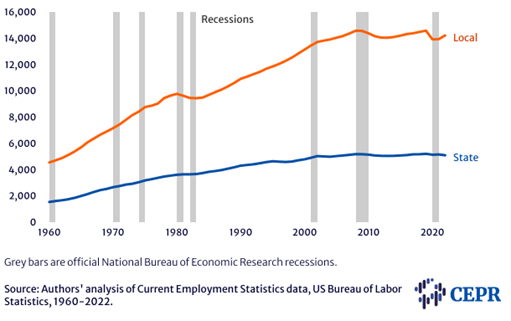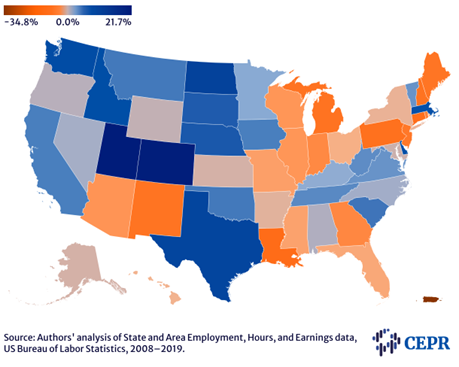 The US is facing one of its most important elections at the same time Congress is experiencing polarization induced legislative gridlock. Chris Gilson writes that it’s important to remember the importance of state and local governments in US policymaking and policy implementation. Many of these governments are facing reduced budgets following the COVID-19 pandemic and other barriers to organisational learning and institutional memory, such as staff churn and legislative term limits. He considers how an online tool could help to level the state and local government policy learning landscape.
The US is facing one of its most important elections at the same time Congress is experiencing polarization induced legislative gridlock. Chris Gilson writes that it’s important to remember the importance of state and local governments in US policymaking and policy implementation. Many of these governments are facing reduced budgets following the COVID-19 pandemic and other barriers to organisational learning and institutional memory, such as staff churn and legislative term limits. He considers how an online tool could help to level the state and local government policy learning landscape.
This year began with what has been called a “humanitarian crisis” of homelessness in California – a state which if it was a country, would have one of the largest economies in the world. The Golden State’s issues with the unhoused have been put into sharp relief in recent weeks with the US Supreme Court to decide on whether the homeless have a right to camp on public land following the state government’s attempt to clear sidewalks and parks of homeless encampments.
In December, the US Department of Housing and Urban Development (HUD) reported that more than 650,000 people across the United States had experienced homeless on a single night in January 2023, a 12 percent increase from 2022, and the largest number of homeless counted since the Department’s ‘point in time’ survey began 15 years ago. HUD Secretary, Marcia L. Fudge, commented on the figures, that “This data underscores the urgent need for support for proven solutions and strategies that help people quickly exit homelessness and that prevent homelessness in the first place”.
Problems appear national but the solutions are often local.
While the US federal government has policy tools to tackle issues like homelessness nationally, most of the work to address these issues happens at the state and local level. Using spending as a proxy for the ‘work’ of policy implementation, US state and local governments spent $3.5 trillion in 2020, compared to $6.6 trillion by the federal government (much of this federal spending, is transfers to people or state and local governments).
Following the end of the COVID-19 pandemic, much of the federal-level assistance that helped to address issues like homelessness has tapered off or ended altogether. And yet, as the recent homelessness statistics suggest, these issues remain. For more than 90 years, the US states have been known as “laboratories of democracy”, meaning that the US-federal system allows the states to experiment to determine which policies work for the problems they face, and which do not. And there are many examples of states and cities introducing and managing policies which are successful in reducing homelessness: in Texas, Pennsylvania, Iowa, Colorado, and Utah to name a few.
What’s stopping effective policy from spreading from state to state?
But if some states have been making progress, why do others struggle? California, for instance, according to the HUD statistics mentioned above had over 181,000 people experiencing homelessness in 2022, over a quarter of the total, despite the state making up 12 percent of the total US population.
Despite the importance of their work – and like many organizations outside of the private sector – state and local governments have experienced straitened resources. As Figure 1 shows, after experiencing decades of growth, state and local government employment has flattened or declined since the great recession of 2008-2010.
Figure 1 – Number of state and local government employees in thousands

And the post-recession recovery in state and local government has not been uniform across the US, either, as Figure 2 shows, with many states still working with fewer resources to tackle the problems they face.
Figure 2 – Percent Change in State and Local Government Employment, 2008–2019

Access to information about how to solve problems is key for public servants to do their job. In conversations with those working in state and local government in the US, I’ve uncovered three difficulties they have with having enough information:
Too busy to learn well
Those who make and implement policy at the state and local level are facing increasingly limited resources as outlined above. Falling resources at least in some states mean that staff time is also becoming increasingly limited as declining staff budgets leave employees “firefighting”. This can mean that those charged with developing and implementing policy often do not have enough time to take lessons from their work, and from elsewhere.
Not knowing enough
Staff churn is a known problem in US government. This combined with an aging workforce and the often-increasing attraction of private sector salaries mean that institutional memory about successful policy is being undertime. In addition, 28 percent of all state legislative seats in the US are term limited, further attenuating institutional memory loss.
Often limited information networks
Learning about which policies work and which don’t need to come from somewhere. This can be from policymakers and bureaucrats’ own experiences, policy reports, academic literature, professional networks, or policy ‘enterpreneurs’. Often these networks can be reliant on existing relationships or shared experiences such as annual conferences or shared university experiences. Larger states are also more likely to have dedicated policy functions which in turn can give them a learning and innovation advantage. On a basic geographic level, states often tend to take the most lessons from those closest to them (although this may have been supplanted by ideological similarity in recent years).
This can be further complicated by politics; it’s not surprising that states led by either of the main parties often tend to learn from states run by administrations from the same party. Relatedly, politically motivated lobbying groups often take advantage of civil servants who have little time by providing them with bill pro-formas for easy policy-making.
Could an intermediary help democratize policymaking?
The factors above add up to an uneven and often unequal policy learning landscape for state and local policymakers. Some have access to resources to help them to learn and to learn lessons about what works and what doesn’t, while others are time-poor and have fewer opportunities for policy learning. With these constraints, many policymakers are using a “good-enough” approach to policy development. But how policy is developed and implemented is incredibly important – should we be settling for “good enough”?
We have had access to online tools, such as Google, to search out and sort information for over 25 years; these tools help us to find out what we want quickly. Given the information constraints felt by policymakers and civil servants, an online tool could help to level the learning landscape, enabling learning and building a collective institutional memory that would withstand term limits and other challenges.
We’re building a solution…
In the next piece in this series, I’ll outline how the State of the States platform can help those working on state and local policy issues to overcome these challenges by making connections with other who have tackled policy problems and providing a space for ongoing institutional memory.
…and we need your thoughts and help
If you work on policy, are you experiencing these sorts of problems and challenges? Do you think this sort of tool would be helpful in your work? By answering these questions you can get involved, and make a difference to this project as it grows.
- Want to get in touch about The State of the States project? Email Chris Gilson at c.h.gilson@lse.ac.uk.
- The author would like to acknowledge the contribution of Jason Clark, the 2023-24 LSE Phelan US Centre Undergraduate Research Assistant for The State of the States project in assisting with the literature review which contributed to this article.
- Featured image credit: Photo by Leo_Visions on Unsplash
- Please read our comments policy before commenting.
- Note: This article gives the views of the author, and not the position of USAPP – American Politics and Policy, nor the London School of Economics.
- Shortened URL for this post: https://bit.ly/42Lg2mi






